Exploration of potential biomarkers and immune cell infiltration characteristics for peripheral atherosclerosis in sjögren's syndrome based on comprehensive bioinformatics analysis and machine learning
- PMID: 40809841
- PMCID: PMC12343227
- DOI: 10.3389/fgene.2025.1546315
Exploration of potential biomarkers and immune cell infiltration characteristics for peripheral atherosclerosis in sjögren's syndrome based on comprehensive bioinformatics analysis and machine learning
Abstract
Background: Sjögren's syndrome (SS) is an autoimmune disorder impacting exocrine glands, while peripheral atherosclerosis (PA) demonstrates a close link to inflammation. Despite a notable rise in atherosclerosis risk among SS patients in prior investigations, the precise mechanisms remain elusive.
Methods: A comprehensive analysis was conducted on seven microarray datasets (GSE7451, GSE23117, GSE143153, GSE28829, GSE100927, GSE159677, and GSE40611). The LIMMA package, in conjunction with weighted gene co-expression network analysis (WGCNA), provides a robust method for identifying differentially expressed genes (DEGs) associated with peripheral atherosclerosis (PA) in Sjögren's syndrome (SS). Subsequently, machine learning algorithms and protein-protein interaction (PPI) network analysis were employed to further investigate potential predictive genes. These findings were utilized to construct a nomogram and a receiver operating characteristic (ROC) curve, which assessed the predictive accuracy of these genes in PA patients with SS. Additionally, extensive analyses of immune cell infiltration and single-sample gene set enrichment analysis (ssGSEA) were conducted to elucidate the underlying biological mechanisms.
Results: Using the LIMMA package and WGCNA, 135 DEGs associated with PA in SS were identified. PPI network analysis revealed 17 candidate hub genes. The intersection of gene sets identified by three distinct machine learning algorithms highlighted CCL4, CSF1R, and MX1 as key DEGs. ROC analysis and nomogram construction demonstrated their high predictive accuracy (AUC: 0.971, 95% CI: 0.941-1.000). Analysis of immune cell infiltration showed a significant positive correlation between these hub genes and dysregulated immune cells. Additionally, ssGSEA provided critical biological insights into the progression of PA in SS.
Conclusion: This study systematically identified three promising hub genes (CCL4, CSF1R, and MX1) and developed a nomogram for predicting PA in SS. Analysis of immune cell infiltration demonstrated that dysregulated immune cells significantly contribute to the progression of PA. Additionally, ssGSEA analysis offered important insights into the mechanisms by which SS leads to PA.
Keywords: Sjögren’s syndrome; bioinformatics analysis; biomarkers; immune infiltration; machine learning; peripheral atherosclerosis.
Copyright © 2025 Liu, Wang, Zhou, Cai, Tang, Wang and Zhang.
Conflict of interest statement
The authors declare that the research was conducted in the absence of any commercial or financial relationships that could be construed as a potential conflict of interest.
Figures
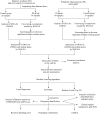

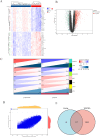
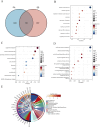
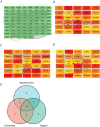

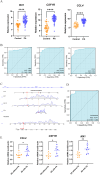
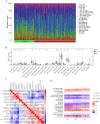
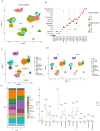
Similar articles
-
The role of mitochondria-related genes and immune infiltration in carotid atherosclerosis: identification of hub targets through bioinformatics and machine learning approaches.Front Genet. 2025 Aug 5;16:1597445. doi: 10.3389/fgene.2025.1597445. eCollection 2025. Front Genet. 2025. PMID: 40836955 Free PMC article.
-
Deciphering the transcriptomic characteristic of lactate metabolism and the immune infiltration landscape in abdominal aortic aneurysm.Biochem Biophys Res Commun. 2025 Aug 30;776:152198. doi: 10.1016/j.bbrc.2025.152198. Epub 2025 Jun 14. Biochem Biophys Res Commun. 2025. PMID: 40532306
-
Deciphering Shared Gene Signatures and Immune Infiltration Characteristics Between Gestational Diabetes Mellitus and Preeclampsia by Integrated Bioinformatics Analysis and Machine Learning.Reprod Sci. 2025 Jun;32(6):1886-1904. doi: 10.1007/s43032-025-01847-1. Epub 2025 May 15. Reprod Sci. 2025. PMID: 40374866
-
Lactate-related genes signature as a novel prognostic landscape in laryngeal squamous cell carcinoma: insights from 156 machine learning algorithms and in vitro validation.Int J Biol Macromol. 2025 Aug 24;323(Pt 1):147098. doi: 10.1016/j.ijbiomac.2025.147098. Online ahead of print. Int J Biol Macromol. 2025. PMID: 40858160 Review.
-
Understanding Sex Differences in Autoimmune Diseases: Immunologic Mechanisms.Int J Mol Sci. 2025 Jul 23;26(15):7101. doi: 10.3390/ijms26157101. Int J Mol Sci. 2025. PMID: 40806232 Free PMC article. Review.
References
LinkOut - more resources
Full Text Sources
Miscellaneous

